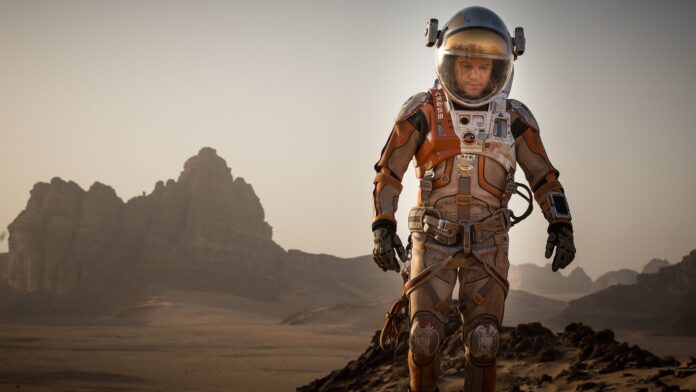The most -selling story of “The Martian” expects that by 2035, NASA will get human beings three times, and it was an example of flight flight systems to return to Earth and cooperated with the Chinese National Space Administration.
We have now exceeded 10 years of Hollywood release for 2015 and 10 years of shy years of fictional schedule. At this midfield, exploration of Mars seems a bit different from how it was photographed in “The Martian”, with more discoveries and more controversy.
As a geologist for planets, he works with NASA’s missions to study Mars, I follow the science and politics closely. In 2010, the US National Space Policy set goals for the human missions of Mars in the twenties of the last century.
But in 2017, directing the White House space policy 1 transformed NASA’s focus towards returning to the moon under what would become the Artemis program.
Although the concepts of missions that were created to Mars have gained popularity, NASA’s actual plans to land human beings on Mars remain fragile.


Mechanical discoveries
Since 2015, the satellites and the Rover have reshaped scientists’ understanding of Mars. They have revealed endless visions on how to change its climate over time.
Like Earth’s neighbors, climatic transformations on Mars also reflect the operations of the solar system that affects the Earth at a time when life was falling for the first time. Thus, Mars became a pivotal point for investigating old questions “Where do we come from?” And “Are we alone?”
The opportunity, curiosity, and perseverance Rovers pushed dozens of miles studying rock formations with layers that work as a record for Mars. By studying sedimentary layers – stacked rock formations such as layers of cake – planetary geologists collected a living story of environmental change that dwarfs what the Earth is currently witnessing.
Mars was one day a world of volcanoes, ice rivers, lakes and flowing rivers – an environment that is not different from the early earth. Then his heart cools, his magnetic field stumbled and the atmosphere wasted.
The surface of the open planet has retained the signs of these operations since then in the form of landscape patterns, sedimentary sequences and metal mixtures.


Arabic Terra
One of the concentration of scientific investigation over the past ten years is in particular on the position of “Mars”, but it has failed to obtain a male in the story. To reach the best opportunity to survive, the protagonist, Mark Watteni, who is played by Matt Damon, must cross a vast, dusty and feared area of Mars known as Arabic Terra.
In 2022 and 2023, I, along with their colleagues at the Northern Arizona University and Johns Hopkins University, published detailed analyzes of layers with layers using pictures of Mars reconnaissance satellites and satellites of Mars Odyssey.
Using infrared images and measuring the dimensions of the surface features, we have tied multi -layer deposits with the same configuration rings and learned more about the widely dominant nature of the terrain that was seen there today. Since the water tends to consolidate the rocks tightly together, this loose substance indicates that about 3.5 billion years ago, this region had a drying climate.
To make discussions on this field easier, we have worked with the International Astronomical Union, to name a few, and not limited to the excavation whose name was not mentioned in the story. For example, Watney, who was now being moved by the name Kozova Crate, is called a town in Ukraine.
More to explore
Despite rapid progress in Mars science, many unknown remains. Scientists are still not sure of fine ages, weather conditions and possible signatures of life associated with all different types of rocks that have been observed on the surface.
For example, the Rover perseverance team was recently dug into a unique group of rocks that host membership-any carbon-based vehicles. Organic compounds act as a building building for life, but a more detailed analysis is needed to determine whether these specific rocks host microbial life.
The mission of returning MARS under development aims to address these basic prominent questions by providing the first unchanging fragments in another world to Earth. The ROVER team is already storing a temporary storage of rock samples and soil, including those that host organic compounds, in sealed tubes. A future weapon will then need to capture the cache and launch it to the ground.
Once home, researchers can examine these materials with more sensitive tool orders than anything that can be transferred on a spacecraft. Scientists stand to learn more about the ability to influence and geological history and the presence of any signs of life on Mars through a campaign to return the sample instead of sending humans to the surface.
This perspective is the reason that NASA, the European Space Agency and others have invested some of 30 billion US dollars in exploring Mars since the 1960s. The reward was amazing: This work has sparked rapid technological progress in robots, wireless and material science. For example, MARS MSSION technology has led to better threads for heart surgery and cars that can drive itself.


Call the red planet’s house?
The colonization of Mars has an attractive call. It is difficult not to get rid of the invincible human spirit while watching storms, and I want the battle of dust, a lack of oxygen and the scarcity of food more than 140 million miles from the rescue.
Much of the momentum towards colonization of Mars is now linked to Spacex and its CEO Elon Musk, which has become its declared mission to make humanity “multiple lines” a kind of crying. But while the colonization of Mars is romantic on paper, it is extremely difficult to do it, many critics questioned the validity of the Mars residence as a shelter away from the ground.
Now, as NASA is likely to face a decrease of approximately 50 % in the science budget, the United States risks the perfectly of planetary science portfolio and automatic operations, including the return of the sample.
However, President Donald Trump and Mossk prompted exploring human space to advance in one way or another, despite these proposed cuts-actually confused the science-based automated programs that have supported both Mars exploring so far.
However, it is these programs that resulted in the richest visions of humanity on the red planet, and given each of the scientists and storytelling narrators such as Andy Wrier the basis to imagine what should be to stand on the surface of Mars at all.
Ari Cuvell, post -doctoral scientist in Earth Sciences and Planets, Dartmouth College
This article has been republished from Conversation Under the creative public license. Read The original article.


